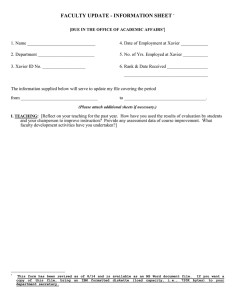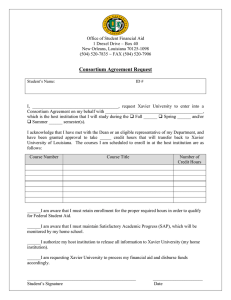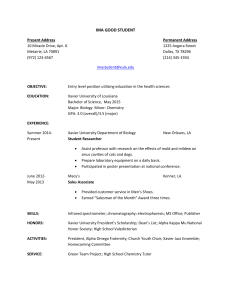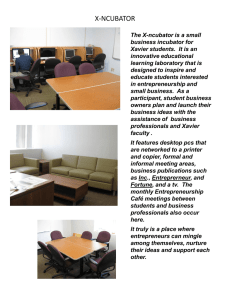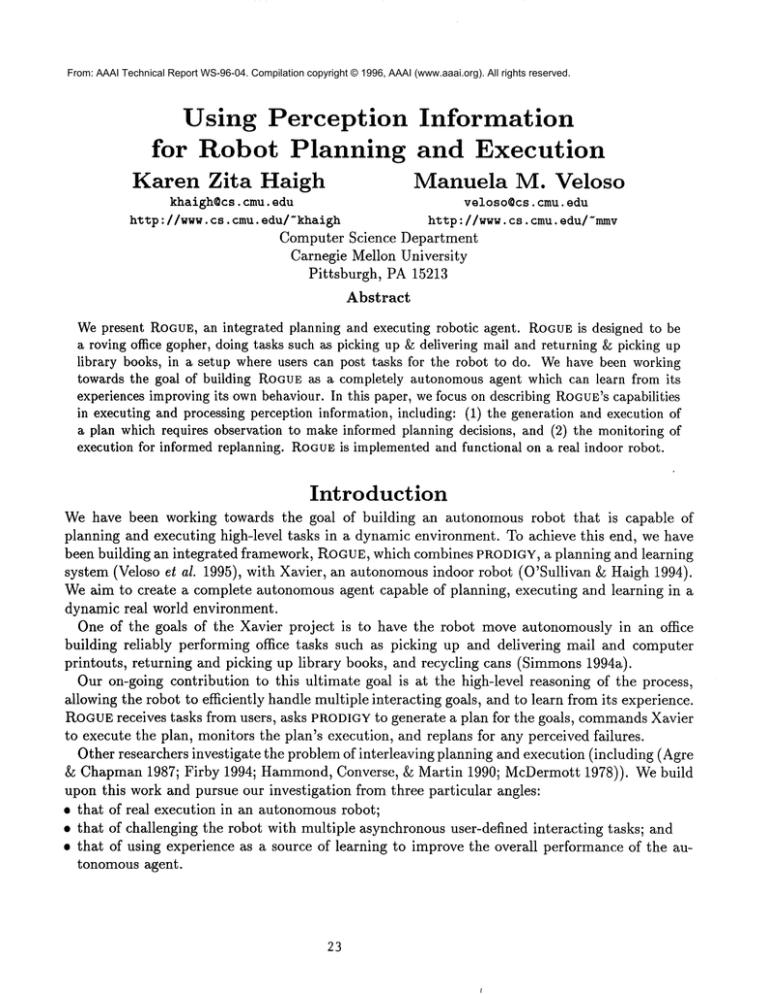
From: AAAI Technical Report WS-96-04. Compilation copyright © 1996, AAAI (www.aaai.org). All rights reserved.
Using Perception
for Robot Planning
Karen Zita
Haigh
Information
and Execution
Manuela
M. Veloso
khaigh@cs,
cmu.edu
veloso@cs,
cmu.edu
http://www.
cs.cmu.edu/~khaigh
http://www.
cs.cmu.edu/~mmv
Computer Science Department
Carnegie Mellon University
Pittsburgh, PA 15213
Abstract
Wepresent RoGuE,an integrated planning and executing robotic agent. ROGUE
is designed to be
a roving office gopher, doing tasks such as picking up & delivering mail and returning ~ picking up
library books, in a setup where users can post tasks for the robot to do. Wehave been working
towards the goal of building ROGUE
as a completely autonomousagent which can learn from its
experiences improvingits ownbehaviour. In this paper, wefocus on describing ROGUE’s
capabilities
in executing and processing perception information, including: (1) the generation and execution
a plan which requires observation to makeinformed planning decisions, and (2) the monitoring
execution for informed replanning. RoGuEis implementedand functional on a real indoor robot.
Introduction
Wehave been working towards the goal of building an autonomous robot that is capable of
planning and executing high-level tasks in a dynamic environment. To achieve this end, we have
been building an integrated framework, ROGUE,
which combines PRODIGY, a planning and learning
system (Veloso et al. 1995), with Xavier, an autonomousindoor robot (O’Sullivan & Haigh 1994).
Weaim to create a complete autonomousagent capable of planning, executing and learning in a
dynamic real world environment.
One of the goals of the Xavier project is to have the robot move autonomously in an office
building reliably performing office tasks such as picking up and delivering mail and computer
printouts, returning and picking up library books, and recycling cans (Simmons1994a).
Our on-going contribution to this ultimate goal is at the high-level reasoning of the process,
allowing the robot to efficiently handle multiple interacting goals, and to learn from its experience.
ROGUE
receives tasks from users, asks PRODIGY to generate a plan for the goals, commandsXavier
to execute the plan, monitors the plan’s execution, and replans for any perceived failures.
Other researchers investigate the problem of interleaving planning and execution (including (Agre
& Chapman1987; Firby 1994; Hammond,Converse, & Martin 1990; McDermott 1978)). Webuild
upon this work and pursue our investigation from three particular angles:
¯ that of real execution in an autonomousrobot;
¯ that of challenging the robot with multiple asynchronous user-defined interacting tasks; and
¯ that of using experience as a source of learning to improve the overall performance of the autonomous agent.
The learning algorithm of the system is the focus of our current work and will be the topic of
future papers. Our work focusses on the interleaving of planning and execution by a real robot
within a framework with the following sources of incomplete information:
¯
¯
¯
¯
the
the
the
the
tasks requested by the users are not completely specified,
set of all the goals to be achieved is not knowna priori,
domain knowledge is incompletely or incorrectly specified, and
execution steps sent to the robot may not be achieved as predicted.
Currently, ROGUE’smain features are (1) the ability to receive and reason about multiple asynchronous goals, suspending and interrupting actions when necessary (described in a previous paper (Haigh & Veloso 1996)), (2) the ability to deliberately sense the world to update its domain
model, and (3) the ability to sense, reason about, and correct simple execution failures.
In this paper, we focus on presenting how ROGUEuses observation to make informed planning
decisions when the domain knowledge is incomplete, and also how the system monitors execution
to adapt to a changing environment, in particular when actions fail or have unexpected effects.
The paper is organized as follows: In Section 2 we introduce the ROGUEarchitecture,
our
developed integrated system. We illustrate
how ROGUEuses observation of the environment to
create correct plans in Section 3. We describe how ROGUE
adapts to a dynamic world in Section 4,
discussing failed actions as well as unexpected outcomes. Wepresent a brief review of related work
in Section 5. Finally we provide a summary of ROGUE’scurrent capabilities
in Section 6 along
with a description of our future work to incorporate learning methods into the system.
General
Architecture
1 is the system built on top of PRODIGY4.0 to communicate with and to control the
ROGUE
high-level task planning in Xavier 2. The system allows users to post tasks for which the planner
generates a plan, delivers it to the robot, and then monitors its execution. ROGUE
is intended to
be a roving office gofer unit, and will deal with tasks such as delivering mail, picking up printouts
and returning library books.
Xavier is a mobile robot being developed at CMU(O’Sullivan & Haigh 1994) (see Figure l(a)).
It is built on an RWI B24 base and includes bump sensors, a laser range finder, sonars and a
color camera. Control, perception and navigation planning are carried out on two on-board Intel
80486-based machines. Xavier can communicate with humans via an on-board lap-top computer
or via a natural language interface.
The software controlling Xavier includes both reactive and deliberative behaviours, integrated
using the Task Control Architecture
(TCA) (Simmons 1994b; Simmons, Lin, & Fedor 1990).
TCAprovides facilities
for scheduling and synchronizing tasks, resource allocation, environment
monitoring and exception handling. The reactive behaviours enable the robot to handle real-time
local navigation, obstacle avoidance, and emergency situations (such as detecting a bump). The
deliberative behaviours include vision interpretation,
maintenance of occupancy grids ~ topological
maps, and path planning & global navigation (an A* algorithm).
1In keeping with the Xavier theme, ROGUE
is namedafter the "X-men"comic-bookcharacter whoabsorbs powers
and experience from those around her. The connotation of a wanderingbeggar or vagrant is also appropriate.
2Wewill use the term Xavier whenreferring to features specific to the robot, PRODIGYto refer to features
specific to the planner, and ROGUE
to refer to features only seen in the combination.
PRODIGY
is a domain-independent problem solver that serves as a testbed for machine learning
research (Carbonell, Knoblock, ~ Minton 1990; Veloso et al. 1995). PRODIGY4.0
is a nonlinear
planner that uses means-ends analysis and backwardchaining to reason about multiple goals and
multiple alternative operators to achieve the goals. The planning reasoning cycle involves several
decision points, including which goal to select from the set of pending goals, and which applicable
action to execute. Dynamicgoal selection from the set of pending goals enables the planner to
interleave plans, exploiting common
subgoals and addressing issues of resource contention.
PRODIGY
and Xavier are linked together using TCAas shown in Figure l(b).
UserRequest
UserRequest
(,~o~u,)
ROGUE
User Request "I’’~
~
plan Steps
Xavier
Monitor
Ex~uUon
TCA
(TaskControlArchitecture)
[ReidSimmonll
Navigate
(a)
[ (sonar,laser)
i
Vision
(b)
Figure1: (a) Xavierthe Robot;(b) RogueArchitecture
PRODIGY
maintains an internal model of the world in which it simulates the effects of selected
applicable operators. Applying an operator gives the planner additional information (such as consumption of resources) that might not be accurately predictable from the domain model. PRODIGY
also supports real-world execution of its applicable operators whenit is desirable to knowthe actual outcome of an action (Stone & Veloso 1995); for example, when actions have probabilistic
outcomes, or the domainmodel is incomplete and it is necessary to acquire additional knowledge.
Someexamples of the use of this feature include shortening combinedplanning and execution time,
acquiring necessary domain knowledgein order to continue planning (e.g. sensing the world), and
executing an action in order to knowits outcome and handle any failures. ROGUE
uses the execution feature of PRODIGYto send commandsto the robot, monitoring the outcome of the actions,
and updating PRODIGY’s domain knowledge as necessary.
Model Updates
Through Observation
In this section we present ROGUE’sbehaviour in more detail. Wedescribe in particular the
interaction between the planner and the robot, showing how symbolic action descriptions are
turned into robot commands,as well as howdeliberate observation is used by the system to make
intelligent planning decisions.
25
The key to this communicationmodel is based on a pre-defined language and model translation
between PRODIGYand Xavier. PRODIGY
relies on a state description of the world to plan. ROGUE
is capable of converting Xavier’s actual perception information into PRODIGY’s
state representation, and ROGUE’s
monitoring algorithm determines which information is relevant for planning and
replanning. Similarly ROGUE
is capable of translating plan steps into Xavier’s actions commands.
Therefore, the fact that ROGUE
needs to link a symbolic planner with a robotic executor entails
the following modular capabilities:
¯ PRODIGY’S plan steps are mapped into Xavier’s commands;
¯ PRODIGY’s state representation is a model of the execution environment;
¯ Xavier’s perception information is abstracted into PRODIGY’Sstate information;
¯ PRODIGYis capable of generating partial plans for execution in a continuous way;
¯ PRODIGYre-evaluates the goals to be achieved continuously based on its state information.
Weillustrate the incorporation of perception information from execution into planning through
an example corresponding to event 1 from the upcoming AAAI1996 robot competition. The
environment consists of three conference rooms and several offices. In this particular event, the
director wishes to schedule a meeting in a conference room. The robot needs to find an empty
conference room and then inform all the meeting attendees. This task is presented as a single
request to ROGUE.
It requires the system to incorporate observation knowledgeinto its planning
in order to accurately and efficiently complete the task.
WhenROGUE
receives the task request, it spawns a PRODIGY run, giving PRODIGY
relevant
task information such as whoare the attendees and which rooms are potential conference rooms.
PRODIGY
incorporates as part of its state knowledge, a topological mapof the environment with
the location of the rooms. It does not have complete information of the exact location of the doors.
PRODIGY
starts creating a plan by alternating considering the goals and their subgoals and the
different ways of achieving them. WhenPRODIGY finds that there are several possible conference
rooms, it applies control knowledgeto select the closest roomto its current location, as the first
one to check for availability. WhenPRODIGY reaches its first opportunity to simulate the effects
of the operator, ROGUE
interrupts and sends the action to Xavier for real-world execution. Each
of the symbolic actions described in the domain model is mappedto a commandsequence suitable
for Xavier. The commandsequences may be executed directly by the ROGUE
module (e.g. an
action like finger), or sent via the TCAinterface to the Xavier module designed to handle the
command. For example, the action <GOT0-R00M
ROOM>)
is mapped to the commands(1) find
coordinates of the room, and (2) navigate to those coordinates.
Figure 2 shows a partial trace of a run. WhenPRODIGY applies the <GOT0-R00N>
operator in
its internal world model (see node n14), ROGUE
sends the commandto Xavier for execution. Each
line marked "SENDING
COMMAND"
indicates a direct commandsent through the TCAinterface to
one of Xavier’s modules.
The TCAcommandnavigateWoG(goal) (used after node n14) creates a path from the current
cation to the requested location, and then uses probabilistic reasoning to navigate to the requested
goal. The module performs reasonably well given incomplete or incorrect metric information about
the environmentand in the presence of noisy effectors and sensors.
This example shows the use of two more TCAcommands, namely C_observe and C_say (after
nodes n14 and n18). The first commandis a direct perception action. The observation routine
can vary depending on the kind of information needed. It can range from an actual interpretation
26
n2 (done)
n4 <*finish*>
n5 (mtg-scheduled)
Firing prefer bindings LOOK-AT-CLOSEST-CONF-ROOM-FIRST #<5309> over #<5311>
n7 <schedule-meeting 5309> [1]
n8 (conference-room 5309)
nlO <select-conference-room 5309>
nll (at-room 5309)
n13 <goto-room 5309>
n14 <GOTO-ROOM 5309>
SENDING COMMAND (tcaExecuteCommand"C_say ....Going to room 5309")
ANNOUNCING: Going to room 5309
SENDING COMMAND (TCAEXPANDGOAL "navigateToG" #(TASK-CONTROL::MAPLOCDATA 567.0d0 3483.0d0))
...waiting...
Action NAVIGATE-TO-GOAL finished (SUCCESS).
n16 (room-empty 5309)
n17 <observe-conference-room 5309>
n18 <OBSERVE-CONFERENCE-ROOM 5309>
SENDING COMMAND (tcaExecuteCommand "C_observe" "5309")
DOING OBSERVE: Room 5309 conf-room
...waiting...
Action OBSERVE finished (OCCUPIED).
SENDING COMMAND (tcaExecuteCommand"C_say ....This room is occupied")
ANNOUNCING: This room is occupied
6
7
n6 schedule-meeting
n15 <schedule-meeting r-5311>
Figure 2: Trace of Rogueinteraction.
of some of Xavier’s sensors or its visual images, to specific input by a user. The commandC_say
sends the string to the speech board.
In this example, once the navigate module has successfully
completed, ROGUE
tells Xavier’s
vision module to observe the room. In this example, the conference room is occupied, and ROGUE
updates PRODIGY’S domain model. In this case, the observation sets the state information that
the room is occupied. Because there are no operators in the domain model that can be used to
empty a room, replanning in this case forces PRODIGY tO use another conference room for the
meeting (i.e. PRODIGY
backtracks to node 7 and selects a different conference room (node 15)).
The run proceeds until ROGUE
finds a conference room that is empty or until it exhausts all
the available conference rooms. After a conference room is found, ROGUEproceeds to announce
the attendees of the location of their meeting. The announcement is made by navigation to each
individual room. The final plan executed by Xavier is shown in Figure 3. Xavier stops at all the
conference rooms until it correctly identifies an empty one, and then tells all the attendees when
27
and where the meeting will be (within 3.5 minutes in 5311). This behaviour was developed
Xavier’s simulator and then applied successfully on the real robot (and will be demonstrated at
the robot competition).
<goto-room 5309>
<observe-meeting-room 5309>
<goto-room 5311>
<observe-meeting-room 53ii>
<select-meeting-room 5311>
<goto-room 5307>
<inform-person-of-meeting director 3.5 5311>
<goto-room 5303>
<inform-person-of-meeting professor-G 3.5 5311>
<goto-room 5301>
<inform-person-of-meeting professor-S 3.5 5311>
Figure 3: Executed
plan
Observing the real world allows the system to adapt to its environment and to makeintelligent
and relevant planning decisions. Observation allows the planner to update and correct its domain
model when it notice changes in the environment. For example, it can notice limited resources
(e.g. battery), notice external events (e.g. doors opening/closing), or prune alternative outcomes
of an operator. In these ways, observation can create opportunities for the planner and it can also
reduce the planning effort by pruning possibilities. Real-world observation creates a more robust
planner that is sensitive to its environment.
Model Updates
Through Execution
Failure
The capabilities described in the preceding section are sufficient to create and execute a simple plan
in a world where all dynamismis predictable. The real world, however, needs a moreflexible system
that can monitor its ownexecution and compensate for problems and failures. Any action that is
executed by any agent is not guaranteed to succeed in the real world. There are several approaches
to reason about the real world uncertainty. In one extreme, planners can completely ignore that
the world is uncertain. They follow a deterministic model and generate a single executable plan.
Whenexecution failures occur, replanning is invoked. This is the current running modeof ROGUE.
Conditional planning in the other extreme, aims at considering in the domainmodel all the possible
contingencies of the world and plan ahead for each individual one. Because it is impossible to
enumerateall the world’s possible events, complete conditional planning is infeasible. Probabilistic
planning falls in the middle of these two frameworks(Blythe 1994). At planning time, it accounts
for the most probable contingencies and relies on replanning if unpredictable or rare events may
take place and disrupt the plan execution. Probabilistic planners may increase the probability
of a plan succeeding, but the domain model underlying the plan is bound to be incompletely or
incorrectly specified. Not only is the world more complexthan a model, but it is also constantly
changing in ways that cannot be predicted. Therefore every agent executing in the real world
must have the ability to monitor the execution of its actions, detect whenthe actions fail, and
compensate for these problems.
28
Gil (Gil 1992), Wang(Wang1995) and desJardins (desJardins 1994) learn or improve
models. Wetake the approach instead of modifying the state description to reflect the outcome
of the action, thereby forcing ROGUE
to find an alternate means to achieve the goal. Ideally,
an approach combining the two methods would be most appropriate for a complete autonomous
agent.
ROGUE
currently monitors the outcome of the navigateTog command, navigateToG may fail
under several conditions, including detecting a bump, detecting corridor or door blockage, and
detecting lack of forward progress. The module is able to compensate for certain problems, such
as obstacles and missing landmarks, and will report success in these situations.
Since the navigate module mayget confused and report a success even in a failure situation,
ROGUE
always verifies the location with a secondary test (vision or humaninteraction). If ROGUE
detects that in fact the robot is not at the correct goal location, PRODIGY’sdomainknowledgeis
updated to reflect the actual position, rather than the expected position.
This update has the direct effect of indicating to PRODIGYthat the execution of an action failed,
and it will backtrack to find a different action which can achieve the goal. PRODIGYexhibits this
replanning behaviour as an inherent part of its design: the actual outcome of an action must be
the same as the expected outcome. Whenthis expectation is invalidated, PRODIGY will attempt
to find another solution.
More concretely, PRODIGY’S algorithm is a state-spaced means-ends planner, which means that
whenit selects a plan action, it simulates the effects of the action in the domainmodel. PRODIGY
cannot simulate the effect of an action until its preconditions are true; when they are false,
PRODIGYsubgoals and looks for a sequence of actions that will achieve them.
In Figure 4, for example, according to its domain model, the robot cannot deliver a particular
item unless it (a) has the item in question, and (b) is in the correct location.
(operator DELIVER-ITEM
(preconds
(and (has-item <item>)
(deliver-loc <location> <item>)
(robot-in-room <location>)))
(effects
((del (has-item <item>))
(add (item-delivered <item>)))))
Figure4: ItemDeliveryOperator.
Since ROGUE
actually forces the real-world execution of the action, and then updates the domain
model with the actual outcome of the action, PRODIGY can detect when an action failed or had
an unexpected outcome. If the action failed, then the goal of the action is not deleted from the
set of pending goals, and PRODIGYis forced to find an alternate meansof achieving it.
In a similar manner, PRODIGY
is able to detect when an action is no longer necessary. If an
action unexpectedly achieves some other necessary part of the plan, then that goal is deleted from
the set of pending goals, and PRODIGYwill no longer plan for it, and in particular will not select
any actions that will redundantly achieve it.
Finally, whenan action accidentally disachieves the effect of a previous action (and the change
is detectable), ROGUE
adds the change to PRODIGY’s
pending goals, forcing PRODIGYto replan.
29
Take for example, a coffee delivery scenario. The system picks up the coffee, adding the literal
(has-item coffee) to its knowledge base and deleting the goal (pickup-item coffee roomA).
If ROGUE
is now interrupted with a more important task, it suspends the coffee delivery and
does the other task. While doing the new task, the coffee gets cold, making the literal (has-item
coffee) untrue. WhenPRODIGY returns to the original task, it examines the next foreseeable
action: (deliver-item coffee roomB), discovers that a precondition is missing (it doesn’t have
the coffee) and will subgoal on re-achieving it.
In this manner, ROGUE
is able to detect simple execution failures and compensate for them.
Our research plan includes finding methods of more informed replanning for a wider variety of
more complex execution failures. The interleaving of planning and execution reduces the need
for replanning during the execution phase and increases the likelihood of overall plan success. It
allows the system to adapt to a changing environment where failures can occur.
Related
Work
Following is a brief description of someof the robot architectures most similar to ROGUE,pointing
out some of the major differences.
PARETO(Pryor 1994), can plan to acquire information and recognize opportunities in the environment (as can ROGUE), but relies on powerful, perfect sensing in a simulated world. It is
also not clear how PARETO handles action failure. Plans for PARETO are created up-front by a
contingency planner which needs to reason about all possible failures, whereas ROGUE
exploits interleaved planning and execution and uses the actual outcome of an action to decide which branch
of the plan to expand, not only reducing the total planning effort, but also the modelling effort
since not all failures need to be predicted.
Gervasio’s completable planning paradigm (Gervasio ~ DeJong 1996) also creates a complete
plan up-front, but instead of creating contingency plans, invokes replanning upon failure. ROGUE
on the other hand interleaves planning with execution reducing both the initial planning and any
replanning efforts: a complete plan does not need to be constructed before execution can begin.
Therefore the planner does not waste effort creating long plans that maybe infeasible in a dynamic
environment. In addition, ROGUE
is implemented on a real robot rather than a simulated one.
Theo (Mitchell et al. 1990) is a system implemented on an indoor mobile robot which applies
explanation-based learning to create stimulus-response rules. It does not support action interruption or uncertainty in the domain, nor does it maintain a state history or modify the action model,
nor can it handle sensor noise.
RoboSoar (Laird et al. 1991; Tambe, Schwamb, ~ Rosenbloom 1995) was a system originally
built on a PUMA
robot arm for blocksworld problems and has since been developed into a simulated fighter pilot. The system relies on perfect sensors and a humanto tell it what features of
the environment are relevant for replanning.
ATLANTIS
(Gat 1992) and RAP (Firby 1994), like TCA,are architectures that enable a library
of behaviours and reactions to be controlled by a deliberative system. The have been used as the
underlying control mechanismon a variety of robots, from indoor mobile robots (Gat 1992) to
space station repair robots (Bonasso ~ Kortenkamp 1996) to unmannedspacecraft (Gat 1996).
Webelieve that ROGUE
is the only such system that can support asynchronous goals, but since
each of these architectures is inherently extensible, the behaviours demonstrated by ROGUE
under
TCAcould be easily transferred to one of the other architectures.
3O
Summary
In this paper we have presented one aspect of ROCUE,an integrated
planning and execution
robot architecture.
In particular,
we have presented the methods by which ROGUEincorporates
execution information into its internal domain model to facilitate
more intelligent
and adaptive
planning. The complete planning & execution cycle for a given task can be summarized as follows:
1.
2.
3.
4.
ROGUErequests a plan from PRODIGY.
PRODIGYpasses executable steps to ROGUE.
ROGUE
translates and sends the planning steps to Xavier.
ROGUE
monitors execution and through observation identifies
goal status; failure means that
PRODIGY~S domain model is modified and PRODIGY may backtrack or replan for decisions
ROGUE
represents a successful integration of a classical
Currently ROGUE’sfeatures include the ability to:
AI planner with a real mobile robot.
¯ receive asynchronous goal requests from multiple users
¯ prioritize goals and focus planning on high priority goals until they are achieved, and then later
resume work on lower priority goals;
¯ recognize similar goals and opportunistically
achieve them;
¯ interleave planning & execution to acquire data and monitor execution; and
¯ deal with simple plan failures, such as arriving at an incorrect location.
An autonomous agent with all of these features has clear advantages over more limited agents.
Although there are a small number of other integrated architectures
which support some of these
features, none appear to support them all.
This work is the basis for machine learning research with the goal of creating a complete agent
that can reliably perform tasks that it is given. We intend to implement more autonomous detection of action failures and learning techniques to correct those failures. In particular, we would
like to learn contingency plans for different situations and when to apply which correction behaviour. We also intend to implement learning behaviour to notice patterns in the environment;
for example, how long a particular action takes to execute, when to avoid particular locations (e.g.
crowded hallways), and when sensors tend to fail. Wewould like, for example, to be able to say
"At noon I avoid the lounge", or "My sonars always miss this door.., next time I’ll use vision", or
even something as apparently simple as "I can’t do that task given what else I have to do."
PRODIGYhas been successfully
used as a test-bed for machine learning research many times
(e.g. (P~rez 1995; Wang1995; Veloso 1994)), and this is the primary reason why we selected it
the deliberative
portion of ROGUE.Xavier’s TCAarchitecture
supports incremental behaviours
and therefore will be a natural mechanism for supporting these learning behaviours.
References
Agre, P. E., and Chapman,D. 1987. Pengi: Animplementationof a theory of activity. In Proceedingsof AAAI-87,
268-272. San Mateo, CA: Morgan Kaufmann.
Blythe, J. 1994. Planning with external events. In de Mantaras, R. L., and Poole, D., eds., Proceedingsof the
Tenth Conferenceon Uncertainty in Artificial Intelligence, 94-101. Seattle, WA:MorganKaufmann.
Bonasso, R. P., and Kortenkamp,D. 1996. Using a layered control architecture to alleviate planning with
incomplete information. In Proceedings of the AAAISpring Symposium"Planning with Incomplete Information
for Robot Problems", 1-4. Stanford, CA:AAAIPress.
31
Carbonell, J. G.; Knoblock, C. A.; and Minton, S. 1990. PRODIGY:
An integrated architecture for planning and
learning. In VanLehn,K., ed., Architectures for Intelligence. Hillsdale, N J: Erlbaum. Also Available as Technical
Report CMU-CS-89-189.
desJardins, M. 1994. Knowledgedevelopment methods for planning systems. In AAAI-94 Fall Symposium Series:
Planning and Learning: On to Real Applications.
Firby, It. J. 1994. Task networks for controlling continuous processes. In Proceedings of AIPS-94, 49-54.
Gat, E. 1992. Integrating planning and reacting in a heterogeneous asynchronous architecture
real-world mobile robots. In Proceedings of AAAI-92, 809-815.
for controlling
Gat, E. 1996. Newsfrom the trenches: An overview of unmannedspacecraft for AI researchers. In Proceedings of
the AAAI Spring Symposium "Planning with Incomplete Information for Robot Problems", 5-12. Stanford, CA:
AAAIPress.
Gervasio, M. T., and DeJong, G. F. 1996. Completable planning: A curative learning approach to the imperfect
domain theory. In Proceedings of the AAAI Spring Symposium "Planning with Incomplete Information for Robot
Problems", 13-16. AAAIPress.
Gil, Y. 1992. Acquiring domain knowledge for planning by experimentation. Ph.D. Dissertation, School of Computer
Science, Carnegie Mellon University, Pittsburgh, PA. Also available as Technical Report CMU-CS-92-175.
Haigh, K. Z., and Veloso, M. 1996. Interleaving planning and robot execution for asynchronous user requests. In
Proceedings of the AAAI Spring Symposium "Planning with Incomplete Information", 35-44. AAAIPress.
Hammond,K.; Converse, T.; and Martin, C. 1990. Integrating planning and acting in a case-based framework.
In Proceedings of AAAI-90, 292-297. San Mateo, CA: Morgan Kaufmann.
Laird, J. E.; Yager, E. S.; Hucka, M.; and Tuck, C. M. 1991. Robo-Soar: An integration of external interaction,
planning, and learning using Soar. Robotics and AutonomousSystems 8(1-2):113-29.
McDermott, D: 1978. Planning and acting. Cognitive Science 2.
Mitchell, T. M.; Allen, J.; Chalasani, P.; Cheng, J.; Etzioni, O.; Ringuette, M.; and Schlimmer, J. 1990. Theo: A
frameworkfor self-improving systems. In VanLehn,K., ed., Architectures for Intelligence. Hilllsdale, N J: Erlbaum.
O’Sullivan, J., and Haigh, K. Z. 1994. Xavier. Carnegie Mellon University, Pittsburgh, PA. Manual, Version 0.2,
unpublished internal report.
P~rez, M. A. 1995. Learning Search Control Knowledge to Improve Plan Quality. Ph.D. Dissertation, School of
Computer Science, Carnegie Mellon University, Pittsburgh, PA. Available as Technical Report CMU-CS-95-175.
Pryor, L. M. 1994. Opportunities and Planning in an Unpredictable World. Ph.D. Dissertation,
University, Evanston, Illinois. Also available as Technical Report number 53.
Northwestern
Simmons,R.; Lin, L.-J.; and Fedor, C. 1990. Autonomoustask control for mobile robots. In Proceedings of the
IEEE Symposium on Reactive Control.
Simmons, R. 1994a. Becomingincreasingly reliable. In Proceedings of AIPS-94, 152-157.
Simmons, Ft. 1994b. Structured control for autonomous robots. IEEE Transactions on Robotics and Automation
10(1).
Stone, P., and Veloso, M. 1995. User-guided interleaving of planning and execution. In Proceedings of the European
Workshop on Planning.
Tambe, M.; Schwamb, K.; and Rosenbloom, P. S. 1995. Building intelligent
pilots for simulated rotary wing
aircraft. In Proceedings of the Fifth Conference on ComputerGenerated Forces and Behavioral Representation.
Veloso, M. M.; Carbonell, J.; P~rez, M. A.; Borrajo, D.; Fink, E.; and Blythe, J. 1995. Integrating planning and
learning: The PRODIGY
architecture. Journal of Experimental and Theoretical Artificial Intelligence 7(1).
Veloso, M. M. 1994. Planning and Learning by Analogical Reasoning. Springer Verlag. (Monograph of Ph.D.
thesis, Carnegie Mellon University, 1992.
Wang, X. 1995. Learning by observation and practice: An incremental approach for planning operator acquisition.
In Proceedings of ML-95.
32


